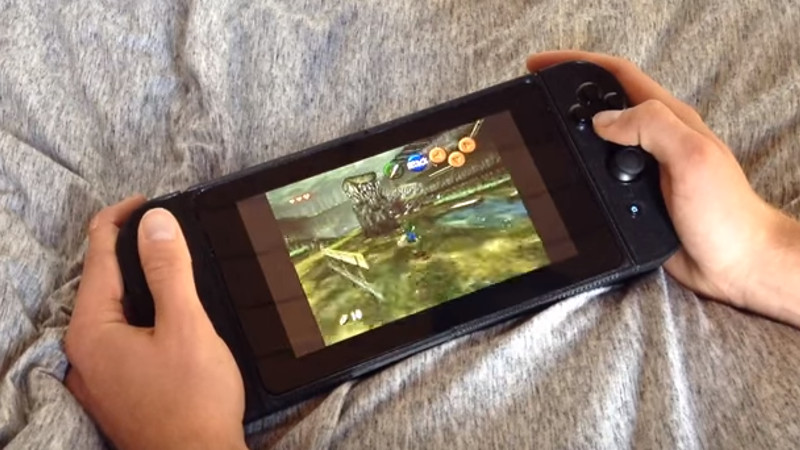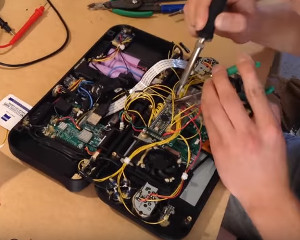Nintendo’s latest Zelda-playing device, the Switch, is having no problems essentially printing money for the Japanese gaming juggernaut. Its novel design that bridges the gap between portable and home console by essentially being both at the same time has clearly struck a chord with the modern gamer, and even 8 months after its release, stores are still reporting issues getting enough of the machines to meet demand.
But for our money, we’d rather have the Raspberry Pi powered version that [Tim Lindquist] slaved over for his summer project. Every part of the finished device (which he refers to as the “NinTIMdo RP”) looks professional, from the incredible job he did designing and printing the case down to the small details like the 5 LED display on the top edge that displays volume and battery level. For those of you wondering, his version even allows you to connect it to a TV; mimicking the handheld to console conversion of the real thing.
[Tim] has posted a fascinating time-lapse video of building the NinTIMdo RP on YouTube that covers every step of the process. It starts with a look at the 3D model he created in Autodesk Inventor, and then goes right into the post-printing prep work where he cleans up the printed holes with a Dremel and installs brass threaded inserts for strength. The bulk of the video shows the insane amount of hardware he managed to pack inside the case, a true testament to how much thought was put into the design.
For the software side, the Raspberry Pi is running the ever popular RetroPie along with the very slick EmulationStation front-end. There’s also a Teensy microcontroller on board that handles the low-level functions such as controlling volume, updating the LED display, and mapping the physical buttons to a USB HID device the Raspberry Pi can understand.
The Teensy source code as well as the 3D models of the case have been put up on GitHub, but for a project like this that’s just the tip of the iceberg. [Tim] does mention that he’s currently working on creating a full build tutorial though; so if Santa doesn’t leave a Switch under the tree for you this year, maybe he can at least give you a roll of filament and enough electronics to build your own.
While this isn’t the first time a Raspberry Pi has dressed up as a Nintendo console, it may represent the first time somebody has tried to replicate a current-generation gaming device with one.


















So…. This is just another emulator project and not an actual homemade switch? Shameful.
Not shameful. It’s a great project that builds on the work of many other folks in the community, and is well worth sharing. Iterative improvements are essential to product development.
I believe what’s shameful is the title of “DIY NINTENDO SWITCH”. You’d expect it somehow to be Switch game compatible somehow (by maybe repackaging the internals in a DIY body), when in reality this is a “homemade switch-like console”. It’s not that’s it’s not well done, just that it’s misleading in its abilities.
There’s legal reasons that prevent it from being current switch game compatible, but if you switched out (hah, pun!) the embedded system for a heftier one, you could probably play a number of modern PC games on it, making it functionally the same albeit with a different library. Heck, since the right embedded system would make it Bluetooth compatible, you could probably even make the controllers removable for that aspect.
It’s a pretty damned slick case design and mounting job.
But I would like to see someone hammer one of these together out of an i.MX6, some DRAM, and a big screen. I think there are companies that basically do that, and sell what are essentially media tablets with buttons and stuff, or a clamshell case, or what-have-you.
No.. Could YOU build a real switch? That’s what I thought. It’s a cool and fun project that took days to make.
Can’t say I’m a Nintendo fan but the tims projects on his website and write ups are quiet neat and well done.
But it can only do so much with emulation, I was playing a dumped copy of N64 Goldeneye on Mupen64, even almost 20 years later it still barely runs on a gaming laptop.
My experience with using a Pi3 as a computer or even a game console is that it is barely enough for the simplest modern web browsing even with Chromium; no modern games, no chance of wine(ARM vs AMD64/x86), and no serious 3d acceleration hardware.
It is unfortunate that we could make all kinds of hot DIY stuff and would undoubtedly increase our purchases if we had the tech data to write more of the drivers vs having to consume only binary drivers for windows, or android and maybe reverse engineer something FOSS, in the wildest scenarios some manufacturers even release the full driver sources with good comments.
The reason why ARM SBCs in general are inadequate performance wise and have limited software options has a lot to do with hardware fragmentation. Every vendor takes the CPU IP from ARM but then integrates their own subsystems be it USB, Ethernet, DMA, e.t.c. This means that OS Kernel must support all of these hardware variations which is an almost impossible task especially when one considers the huge number of ARM Cortex A SOCs out there as well as the Linux Kernel’s development cycle. Add to that the closed source Mali (or similar) GPU/video drivers that are hard to update and integrate because of their ‘blobby’ nature and you got on your hands a real shit show.
While the x86 architecture has its problems, its uniformity makes it easier to develop for under Linux..or any other OS for that matter.
And as underpowered as it maybe the Raspberry Pi 3 is the only ARM based SBC that has demonstrated any kind of longevity beyond 2-3 years (along with the Beaglebone black…though its not as popular). This is why I’m a big fan of the RPi despite it being underpowered. Also remember that the RPi 3 costs only $35. The performance that you get is not bad given the price.
I can’t help but wonder if some high-power LQFP chips might not get us some more creative offerings.
I’d take a hit to RAM/PCI/etc interface speeds if it meant a serious core processor and something I could actually assemble in a prototype stage. I know that there are some LQFP-176 Cortex-A processors out there, but not many spiffy new ones.
Show of hands, who ENJOYS dealing with BGA chips?
“Fragmentation” has nothing to do with it.
Systems like the N64 have dedicated hardware designed from the ground up to handle specifically that. ARM, x86, MIPS, whatever, all have to emulate that. What is one instruction on N64 hardware, becomes dozens or hundreds on a host platform in order to put all of the bit in the right place. This is true of trying to emulate any system with custom silicon. Thats why MAME sound emulation is terrible for games that use custom chips. Etc.
Try a different emulator. Try a different rendering preset in that emulator. I complained about this last week or so I think on HaD. The N64 is apparently very hard to emulate. The games all need a hack cheat sheet of settings to get them to run properly across 4+emulators and probably over 20 different rendering modes total. It is bullshit. I can honestly say though that I had no problemo running Goldeneye. This was back in 2003 or 05. Should be ready to go on most of them. The worst one for me was Mario Golf 64. I wish you luck, my friend.
dave the real goldeneye on console works at 15 fps, 7-10fps in splitscreen multiplayer. Your computer does a good job emulating the slowness.
https://www.youtube.com/watch?v=E2OPxpV_Og8&lc=z235uhtgxkjsu10k4acdp435aczx5fio4aob3pe5bhhw03c010c There are a lot of us out there working on portables of different shapes and sizes.
been working on my own for some time, started with a tablet, decided to stick hardpoints on the end for controllers that ive yet to design. not intending to copy the switch but to run all the ports of classic pc games and emulated games, and to serve as a remote control for robotics projects.
Nice :) Good luck and hope to see ya post your progress as it goes :)
I sort of have a pile of bits… a BBB, a headrest DVD screen etc… but I got hold of a Leapfrog LeapsterGS so might end up just hacking that (Though posted a while back all the links are dead with only a few clues left.)
This is a pretty click bait title. A RetroPie is hardly the gaming machine the switch is… RetroPie is very cool don’t get me wrong but the model 3 can’t even play N64 games. And this is a scratchy 3D printed case… the controllers don’t detach…
Why make a clickbaity title instead of just a good one that tells us this person made somthing cool? Idk maybe I just expect more from hackaday. Or is this buzzfeed now?
Next article: 14 ways to make avocado toast
Finally! We can get Virtual Console!
This is pretty cool, but I don’t think the RetroPie can be comparable to an actual Switch. It’s nice and all, but this looks extremely tacky and hardly comparable in performance and overall feel like an actual Switch. I think the headline overblew it.